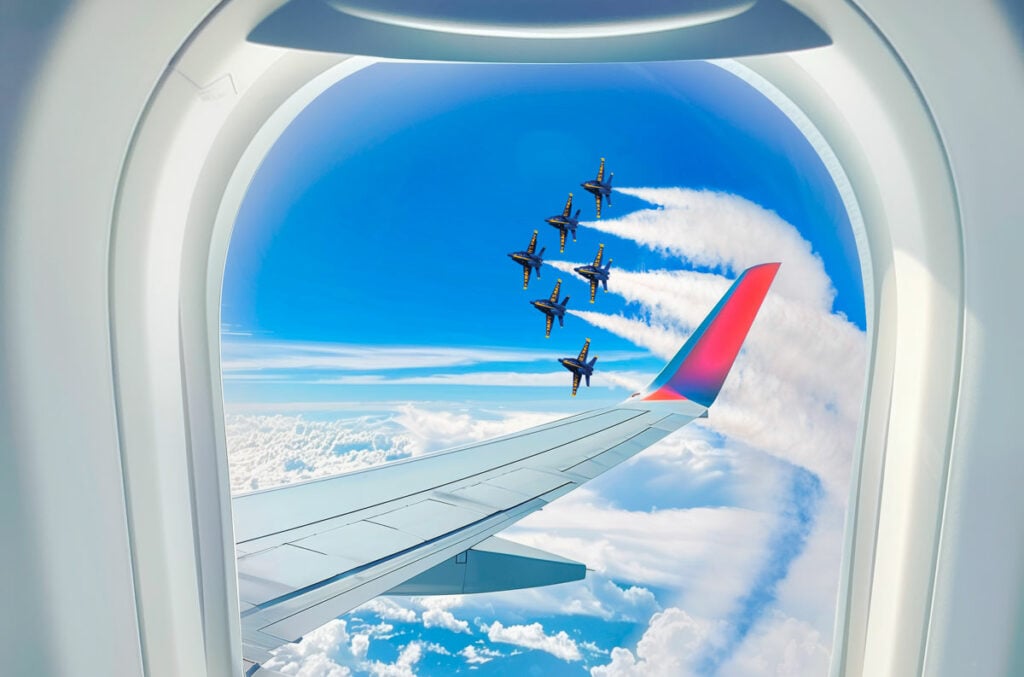The business of aviation in MGM continues to gain altitude and land positive impacts for the region. Montgomery’s prospects and progress have been lifted by the wings of aviation since the fathers of flight, the Wright brothers, based their first flying school in the capital city in 1910. That laid the groundwork for Maxwell-Gunter Air Force Base to locate in Montgomery in 1918. For more than a century, a mutually beneficial relationship between the base and the community has flourished. Today, it’s Montgomery’s largest employer.
And since it first began air services in 1946, The Montgomery Regional Airport at Dannelly Field has served the area, getting residents where they want to go and bringing them home, while bringing in visitors from all over the world to experience the River Region’s warm welcome.
Here at Last
In 2018, it was announced that a fleet of F-35 Lightning II fighter jets would be “bedding down” in the capital city with the historic 187th Fighter Wing. For the last five years, the wing has been preparing for the conversion that will push the entire area to new heights. The total value of the new aircraft, equipment, and facilities is approximately $1.87 billion. The first three jets arrived in December 2023, and more are coming, totaling a fleet of 20 by spring 2026.
According to Lt. Col. Kevin “Smash” Pugh, F-35 Unit Conversion Office (UCO) Director for the 187th, multiple and long-lasting positives landed with the jets. “There is an estimated $30.6 million economic impact, with 380 direct and indirect jobs and 21 supplier locations across Alabama,” he said. “However, that pales in comparison when considering the decades-long impact the new stealth fighter brings. The 187th Fighter Wing’s F-16s were over 35 years old and likely nearing the end of their service life. Brand new F-35s not only provide the Red Tails with an exponential leap in technology, lethality, and survivability, but these fighters will presumably fly for the next four decades.” The World is With Us
Military officers (and their families) from around the globe come to Montgomery to study at the prestigious Air University at Maxwell-Gunter AFB, adding some international flavor to the capital city while they’re here. We asked two female pilots beyond our borders to share a bit about their time in Montgomery and their work in the business of flying.
Major Daniele Lins | Brazilian Air Force
A fighter pilot in the Brazilian Air Force, Lins joined the Air Force in 2003 and graduated in the first class of female pilots in 2006. According to Lins, multi-tasking is the “essential” skill a
successful pilot must possess. “Motor coordination and agile thinking are key. Still, I think the most important thing is the ability to perform several tasks simultaneously,” she said.
While at Maxwell, Lins has been happily surprised by what she’s found. “The teaching staff’s incredible capacity, combined with the student body’s cultural diversity, promotes an environment of cultural plurality and the sharing of different experiences and points of view, creating a unique learning environment. Without a doubt, this is a unique experience in both my professional and personal life.”
Lt. Col. Julissa Laguna | Peruvian Air Force
A helicopter pilot in the Peruvian Air Force, in 2009, Laguna qualified as the first female pilot in her country’s armed forces. She’s been flying for 14 years and named resilience the “essential” pilot skill. “It’s a quality that one must possess to have the calmness and clarity to make decisions in stressful or dangerous situations,” she said.
While Laguna is captivated by flying and “the incredible sensation of being able to see things from the sky,” she also gives motivational talks in schools and other educational institutions to encourage more women to apply to the armed forces. “I’m proud I’ve been able to break a paradigm in my country that said women could not be military pilots because they would fail in forming a family and continuing with a military career,” she said.
Show & Tell
In April, Maxwell-Gunter AFB hosted the 2024 Beyond the Horizon Air and Space Show. With sky-high performances, including the amazing aerial acrobatics of the Navy’s Blue Angels, and static displays, the two-day event tied Maxwell AFB’s aviation history to its forward-looking perspective by showcasing the base’s roles in both the past and the future of air and space power and celebrating both heritage and innovation.
It drew more than 200,000 spectators, including many locals but also visitors who shopped and stayed in the city, adding dollars that boosted the city’s tourism economic impact. But the airshow brings benefits beyond money, according to its director, Lt. Col. Chay M. Derbigny. “It’s just a good time for everyone, but it’s also educational for kids, opening their eyes to the many career possibilities in the air and space industries,” he said. “And it showcases our military capabilities and readiness in a way that I think makes people feel secure and proud.”
Safe & Sound
Montgomery Regional Airport’s Airport Operations Supervisor Myiesha Johnson and her team handle all flight safety-related issues, including diverting planes, runway alerts, and keeping the airfield up to code. Johnson chatted with CentrAL INC! about the important and interesting work they do.
Your job is relatively new, right?
Yes. The duties we handle were previously overseen by airport police, but the airport undergoes a certification inspection each year, and after a not-so-good one, it was decided that a dedicated airport operations team was needed.
What are your main duties?
I oversee a team of six, called Airport Operations Specialists, and we are responsible for the terminal and airfield. We have a checklist we walk through to ensure we meet all the standards and keep everything in order. This includes checking the runway for foreign object debris, making sure all airline vehicles are chalked (so if brakes went out, they wouldn’t roll anywhere), making sure anyone on the ramps is properly badged, checking the perimeter and the chain-link fence for gaps, looking for and addressing any cracks or holes in the runways, and checking that paint markings on runway signs aren’t chipped or discolored and are clearly visible.
What about the impact of wildlife?
Wildlife mitigation is a big part of our job. We keep the grass height 6-12 inches high to help us keep wildlife away. But we still get some. We use game cameras to monitor, and we’ve seen coyotes, foxes, a bobcat, a snapping turtle, and squirrels. Once, there was a lone crawfish walking across the ramp. We were all like, “Where did you come from?” It can be funny, but the birds can be a real problem. Birdstrikes—when a bird hits an airplane—are a serious issue. I joke that I’ve acquired bird rage. I am determined to get them out of the way and off the airfield.
What’s your favorite part of your job?
I have now been in this industry for more than 10 years, but I still get excited about the planes. I still get chills when the big C-130s or the more exotic planes come in. I also love career days where we bring students in to explore aviation opportunities. I especially like engaging with the little girls; this industry is still male-dominated, so I want to show girls they can be a part of this, and they don’t have to be a flight attendant to do it.
Why is it important for Montgomery to have a regional airport?
Flying here keeps money here, and without us, residents have to drive more than an hour to catch a flight. Plus, there’s so much history here—aviation and otherwise—and we love people coming to experience that history being able to fly right into town. I think making it easier for people to come and hear our stories is key to the community. So, we’re always encouraging people to fly local!
Flying-Safe Fun Facts
The Montgomery Regional Airport’s Ops Team has to:
- Keep grass around the airfield between 6-12 inches high. The shorter grass means fewer places for animals to hide, so it discourages many from lurking around the airport.
- Keep an eye out for killdeer. Runways are the preferred nesting sites for this little bird.
- Get and stay wildlife certified. Every year, a biologist teaches the crew animal mitigation tactics, including how to use a “bird banger,” a small gun that shoots out a projectile akin to a bottle rocket to scare birds out of the area.
- Do daily required checks of the outer and inner perimeter (using the airport’s ATV nicknamed Country Girl), and often, do additional inspections, weather permitting.






